Approaches to heritage education in children's audiences in the State of Guanajuato, Mexico
Main Article Content
Abstract
This article aims to present the results of the collective mapping workshops of local heritage in the educational space of the basic level in the state of Guanajuato, Mexico. For this, the mapping workshop was implemented in a basic-level school in the city of León, Guanajuato, Mexico, aimed at a child audience during 2019-2020, with 4 pedagogical strategies for the activity, using criteria established in the analysis of content, buildings of problems detected among boys and girls. The results of the research helped to understand the importance of heritage education in the basic level curricula as a strategy to claim the identity of the Mexican from an early age, in order to comply with the provisions of the Law of Cultural Rights in the State of Guanajuato, in addition to showing the category of recognition that boys and girls have of their local cultural assets, as well as the identification of the skills and abilities developed by them in the aforementioned workshops.
Article Details
References
Bonfil, G. (2003). Nuestro Patrimonio Cultural: Un laberinto de significados. Cuaderno 3 Patrimonio cultural y turismo. Capitulo I. México: CONACULTA.
Falcon, J. & Herrera, R. (2005) Análisis del dato estadístico (Guía didáctica). Universidad Bolivariana de Venezuela, Caracas.
Fontal, O. (2013). La Educación Patrimonial: del patrimonio a las personas. España: Ediciones TREA
H. Congreso del Estado de Guanajuato. (2018) Ley de Derechos Culturales para el Estado de Guanajuato. México.
Horta, M., Grunberg, E.; Monteiro. (1999) A. Guía básica de educación patrimonial. Brasilia: Instituto do Patrimonio Histórico y Artístico Nacional
Levin y Rubín, (1996). Estadísticas para administradores. Editorial Prentice Hall. Mendenhall, R. New Jersey. Estados Unidos de Norteamérica.
Lima, G. (2003). Patrimonio Cultural Regional: estudio Comparativo sobre a legislación protectora en las 32 entidades federativas mexicanas. En revista Derecho y Cultura, núm. 9 marzo-agosto 2003. Pp. 43-98. Instituto de Investigaciones Jurídicas. UNAM. México.
Meneses C. (2018) Patrimonia: Centinela del Patrimonio Cultural. Secretaria de Innovación Ciencia y Educación Superior (SICES). Guanajuato. México.
Taylor, S.J. & Bogdan, R. (1987) Introducción a los métodos cualitativos de investigación. La búsqueda de significados. Barcelona: PAIDOS
Trabajo, M. y Cuenca, J.Mª. (2017). La educación patrimonial para la adquisición de competencias emocionales y territoriales del alumnado de enseñanza secundaria. Pulso. Revista de Educación, 40, 159-174 DOI: https://doi.org/10.58265/pulso.5118
Universidad de Guanajuato. (2018). Normatividad de la Universidad de Guanajuato. México.
UNESCO, 2003, https://es.unesco.org/fieldoffice/santiago/cultura/patrimonio consultado abril 2022.
Vega E. &, Peters E. (2003) Patrimonio y medio ambiente. Cuaderno 3 Patrimonio cultural y turismo. Capitulo I. CONACULTA. México.
Vygotski, L. (1996). El problema de la edad. En L. S. Vygotsky: Obras Escogidas, Tomo IV (pp. 251-273). Madrid. Aprendizaje Visor.

